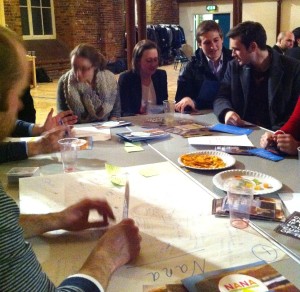
‘Newborn in hospital’ by World Bank Photo Collection (Creative Commons)
Just before I closed down my computer last night, my twitter feed started telling me of the explosions in Boston. The news programmes gave their full attention to the situation a couple of hours later, and by this morning it was still the lead story, with three people confirmed dead and more than 100 injured.
Type ‘Boston’ into your preferred search engine and you’ll have your pick of coverage from all the world’s major news outlets.
Type in ‘Gosnell’ and it’s a very different picture – at least it was 24 hours ago.
Dr Kermit Gosnell is on trial in Philadelphia accused of killing a woman and seven children. The court has heard evidence that these eight people are by no means all the doctor’s victims; in the thirteen years since his clinic’s last inspection, hundreds of healthy newborn babies have been killed by having their spinal cords cut with scissors – “literally a beheading” as one worker at the clinic put it.
Unlike the Boston bombings, however, there has been an almost total lack of media coverage of the horrific revelations from this clinic, which had somehow not been given even the most cursory of inspections for 16 years.
The Grand Jury report makes shocking, stomach-churning reading: Gosnell’s clinic was found to be dirty, staffed by untrained assistants and in violation of just about every hygiene and public health regulation going. Body parts of babies were found stored in jam jars, plastic jugs and even paper bags.
Instruments were not properly sterilized. Disposable medical supplies were not disposed of; they were reused, over and over again. Medical equipment – such as the defibrillator, the EKG, the pulse oximeter, the blood pressure cuff – was generally broken; even when it worked, it wasn’t used. The emergency exit was padlocked shut.
Patients attending the clinic would regularly come away having contracted venereal diseases from the dirty instruments with which they had been treated. Several had to go to hospital to be treated for complications arising from their ‘care’.
I could go on and on.
The facts are truly shocking, yet they have almost entirely failed to hit the news at all. I only know about the case because I have a mild addiction to twitter and at the end of last week I started seeing people asking why #Gosnell wasn’t getting more (ie any) news coverage.
Eventually I found an article which told me the story. If your stomach hasn’t been sickened enough by the above, read the Grand Jury report or this article from Conor Friedersdorf in The Atlantic. It’s pretty distressing stuff.
So why hasn’t it hit the news?
Because this wasn’t just any clinic, it was an abortion clinic which specialised in late-term abortions. The Grand Jury heard evidence that in the three decades of the clinic’s operation, Gosnell and his staff carried out hundreds of late-term abortions – often exceeding the 24-week legal limit (the Grand Jury report estimates that he carried out at least 4 or 5 illegal abortions per week), and killing babies at “30-plus-weeks” of gestation.
Now, I know it is controversial to describe abortion as ‘killing babies’, but the way Gosnell operated, there is no other possible term for it – he would induce labour, putting the women through the ‘normal’ birth procedure and then, if what came out showed signs of life, he would snip its spinal cord with a pair of scissors.
Whatever you call it while in the womb, once a viable bundle of tissue with human DNA enters the world, it stops being a foetus by anybody’s standards and is recognised as a baby. Had Gosnell routinely gone into the maternity ward or premature baby unit at his local hospital cutting babies’ spinal cords, he would have been arrested years ago and vilified as an evil lunatic. The world would know his name and shudder at its mention.
If the health and legal authorities had turned a blind eye, there would have been outcry, with officials from the highest ranks being prosecuted for criminal negligence.
So why the silence on this case?
To be honest, I don’t fully understand.
Abortion, while an emotive and divisive issue in the UK, is an absolutely polarising one in the US, particularly in the media.
Over here journalists seem perfectly capable of supporting ‘a woman’s right to choose’ while at the same time highlighting illegal and unhygienic practices due to failures of regulation. And while I am strongly and committedly pro-life I can see that there is no logical inconsistency in believing that abortion is morally permissible but still wanting it to be carried out in safe, hygienic conditions. In fact, many people who are pro-choice hold that stance due to a conviction that desperate women will seek abortions whether they are legal or not, so legalising and regulating them is a way of ensuring they are treated safely, by proper registered doctors.
In the US, though, it seems journalists are unable to disentangle themselves from the position they hold to report a case which is horrific and newsworthy by anyone’s standards. Perhaps this is a reflection of their honesty – they know that reporting a case of ‘choice gone bad’ will inevitably open up the discussion of what Gosnell’s crime actually was.
It is hard to see why killing a human at 24 weeks of gestation is a perfectly acceptable medical procedure when it takes place inside the womb, but a heinous murder when it takes place a few inches away out in the wide world.
It’s hard to see why killing a loved and wanted infant in a premature baby ward would be sickening, but killing an unwanted one in a clinic is fine – or even why killing an unwanted baby in a clinic is fine, but killing it in a dirty clinic with unsterilized instruments is despicable.
In fact, I don’t think it’s just hard, I think it’s impossible.
Perhaps journalists have realised that, and are – or were – keeping quiet in order to protect their stance. By ignoring this case they can sustain the rhetoric that abortion is nothing more than the disposal of a bunch of inconvenient cells. The briefest glance at the facts – and some of the heart-breaking photos – would tell them differently.
As I hinted at the beginning, however, things are changing. A massive twitter and blogging campaign seems finally to have provoked a response from America’s major news outlets. As the New York Times put it:
…after an online furor that the case was being ignored by the national news media because of troubling accounts of late-term abortions, reporters from major newspapers and television networks descended Monday on the Court of Common Pleas.
I was particularly interested in this article by Sarah Kliff in the Washington Post, as I had seen a story from Mollie Hemingway the day before mentioning Sarah and her claim that she hadn’t written about the story because it was a ‘local crime’ issue, not one that had any bearing on policy which was her true remit. Particular kudos goes to Kliff for not only admitting she was wrong, but also including a link to the relevant twitter conversation in which some of the scathing responses from other tweeters can be seen below the original exchange.
This post has got very long, so let me just close with this: We often feel powerless to make a difference in the world. The problems are too great, the walls too high and too thick for teeny tiny us to hack away at them and make any kind of difference, but the issue of the media coverage in this case shows us differently. As Margaret Mead once said (and President Bartlet quoted!):
Never doubt that a small group of thoughtful, committed citizens can change the world; indeed, it’s the only thing that ever has.














Latest comments